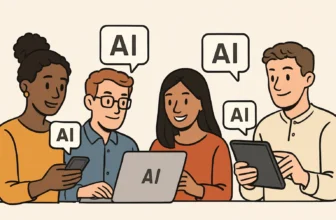
Are You Ready for the Game-Changers in Gaming?
Did you know that over 70% of gamers believe that artificial intelligence will completely change how we play within the next five years? Wild, right? I mean, we’re not just talking better graphics here—we’re talking about entire worlds that think and feel like real life. Welcome to the intersection of AI in gaming and VR innovations, where the boundaries between our world and fantasy aren’t just blurred—they’re dissolving.
Let me paint you a picture: Imagine walking into a game where NPCs not only remember what you did last time but hold a grudge. Where the environment adapts to your decisions. And where you’re not passively hitting A to interact, but literally reaching out with your hand in VR to open a creaky old door in a haunted castle. Sounds intense? Because it is! AI adds brains to the game, VR brings the body—together, they’re giving gaming a whole new soul.
Why Now? What’s The Big Push?
Here’s the deal—gaming tech has always been about trying to make experiences feel more “real,” right? Graphics got sharper, audio got deeper, worlds got bigger. But those changes? Mostly cosmetic. What’s happening now with AI and VR isn’t just surface-level polish. It’s like going from playing chess with a robot to having a fully sentient dungeon master shaping your quest in real time.
And honestly? As a lifelong gamer, I’ve felt that moment when a game surprised me—when an NPC did something totally unexpected because the game “learned” how I played. It gave me chills. Now throw VR into the mix and you’ve got spine-tingling immersion in a whole new way.
How You Can Ride the Wave (Instead of Getting Swept Under)
- For Gamers: Start exploring games already using AI and VR tools—try Half-Life: Alyx for an unparalleled VR experience, or play with mods that implement machine learning behaviors into enemy AI (trust me, it’s both exciting and terrifying).
- For Developers: Dive into Unity or Unreal Engine’s tools for AI behavior customization and VR compatibility. There are tons of resources out there, and you don’t need to reinvent the wheel—just enhance it.
- For Everyone: Stay curious. Follow game dev vlogs, attend a virtual gaming expo, or connect with communities experimenting with AI and VR collaborations. This space is moving faster than Mario on a star power-up.
Ready Player You
Here’s the exciting (and maybe slightly terrifying) part—we’re entering an era where games don’t just respond to us. They anticipate us. They evolve with us. Whether you’re building game worlds or living in them, AI and VR are more than buzzwords—they’re your next co-op partners.
So, the big question: Are you ready to game in a world that plays back? Keep reading, because what’s coming next will blow your player stats right off the leaderboard.
How AI is Personalizing Your Gaming Journey
Did you know that over 70% of gamers quit a game because it feels repetitive or impersonal? Yep—just think about all those lifeless NPCs spouting the same canned lines like, “Stay a while and listen,” or enemies that attack in mindless waves without switching up their strategy. It’s like you’re living the same side-quest déjà vu again and again.
As gamers, we crave something deeper—an experience that feels like it was crafted just for *us*. I mean, how many times have you powered through a game only to feel like you’re just checking boxes? Fun, sure. But meaningful? Not always.
The Problem: One-Size-Fits-All Gameplay
Traditional games tend to follow pretty rigid scripts. NPCs behave the same way no matter what your character does. Enemies don’t adapt to your style. Dialogue trees are predictable. And after a while, you start to notice… the world doesn’t really change based on *you*. That lack of personalization is like watching a great movie—but never getting to decide how it ends.
Personally, I’ve had moments like this in massive RPGs. You invest 80+ hours building your character, forming alliances, and making “big” choices, but in the end, the same final boss fight awaits. All that effort? Feels a little hollow.
The Solution: AI That Actually *Learns* You
Enter AI—and not the old-school “enemy-bot-patroling-a-fixed-path” kind. I’m talking about deeply embedded AI that dynamically adjusts gameplay and characters based on how *you* play. It reads your in-game behavior and curates story arcs, dialogue, and challenges that are uniquely yours.
Some jaw-dropping real-world examples?
- Middle-earth: Shadow of Mordor’s Nemesis System: Enemies remember you. They hold grudges. They taunt you after every battle—and if they escape? They come back smarter and tougher. It’s ridiculously personal.
- Left 4 Dead 2’s AI Director: It tailors the pacing, intensity, and placement of enemies based on your team’s stress level and performance. Had a rough fight? It might chill out and let you breathe. Doing too well? Get ready for a boss wave no one invited.
- S.T.A.L.K.E.R. 2 (upcoming): Promises AI systems where enemies stalk you intelligently, adapting over time rather than just charging straight into your bullets.
For Developers: Making Your Worlds Come Alive
So, what does that mean if you’re building the next great VR game? AI personalization doesn’t have to be out of reach. Here are a few quick-start ideas:
- Use AI-driven analytics to track player behavior and adapt difficulty levels or narrative paths in real-time.
- Implement procedural dialogue systems that let NPCs respond to the player’s actual decisions, not just pre-scripted options.
- Train AI models on user feedback to identify friction points and fine-tune pacing—nothing kills a game vibe like a boss that’s impossible just because the player missed a health upgrade an hour ago.
Even tools like Unity ML-Agents or OpenAI’s GPT can be baked into your dev pipeline to create smarter, more reactive NPCs and quest systems. The key is to think beyond “winning” and start shaping experiences that evolve with the player.
It’s a Game-Changer—Literally
AI-driven personalization doesn’t just make games cooler—it changes how we connect to them. The stories can feel *real*. The characters? They start to matter. And as a developer, you’re not just designing a game. You’re handing players the brush to paint their own journey.
If you’ve ever dreamed of creating a game that players don’t just play—but live through—you’re in the right era. The tools are here. The audience is ready. And let’s be real: no one wants another cookie-cutter side quest. Let’s make this personal.
VR Innovations: Redefining Reality and Play
Did you know that over 90% of gamers still play on flat screens—even though VR has the power to trick your brain into believing you’ve physically *left the room*?
Wild, right? I mean, traditional gaming is great—don’t get me wrong. But let’s admit it: a screen, no matter how high-def or curved, still puts a literal frame around your experience. It’s like peeking through a window into another world… instead of actually being inside it.
I remember the first time I popped on a VR headset. I was supposed to just “test it for a few minutes.” An hour later, I was still ducking behind imaginary crates in a zombie-infested warehouse, heart pounding like I was *really* about to get bitten. That’s the kind of full-on immersion flat screens just can’t touch.
The Limitation of Screens: Why It’s Time to Step Beyond the Glass
You know that feeling when you’re deep into a game, but something just feels a little… off? Like you’re emotionally in it, but visually? Your eyes still know it’s a screen. And your body? It’s just chilling on the couch. That disconnect breaks immersion—and breaks the magic.
Enter: Virtual Reality. With VR, you’re not just watching; you’re *in it*. Instead of using a controller to look around, you actually turn your head. Your physical movements translate into digital actions. It’s next-level stuff—and it’s only getting better.
Okay, But What Does “Truly Immersive” VR Look Like?
This is where it gets exciting. Let me paint you a picture:
- Echo VR: You’re gliding through zero gravity, flinging a disc to teammates in a sci-fi arena. There’s no “up” or “down”—only cool, disorienting freedom.
- Half-Life: Alyx: You’re rummaging through drawers, solving puzzles with your hands, and reloading your gun with spine-tingling realism while an alien growls nearby.
- VR Chat: You’re having conversations with real people using body language and avatars that mimic your movements. It’s socializing, but with light sabers and penguin suits.
See the theme? It’s *presence*. Good VR convinces your brain that, hey, this new reality? Totally real.
Tips for Developers: How to Boost Immersion in Your VR Worlds
If you’re a dev in this space, here’s how to really pull players into your world:
- Make Environments Interactive: Don’t just design pretty scenery—make it touchable. Let users open doors, flip switches, or toss objects. Interactivity = reality reinforcement.
- Use Spatial Audio: Sound is huge. When footsteps echo from behind or a whisper creeps in from the left, you *feel* like you’re surrounded by a living world.
- Optimize Player Comfort: Take motion sickness seriously. Use teleportation locomotion, fade transitions, and visual anchors to help users feel grounded—even when flying through a fantasy world.
I’ve chatted with indie and AAA devs, and this always comes up: “If it’s possible in real life, and it makes sense for your game, let the player *do* it in VR.” That extra mile of realism makes all the difference.
Let’s Keep Pushing the Boundaries
VR isn’t just a gimmick. It’s a gateway to entirely new forms of storytelling, gameplay, and expression. And we’re just scratching the surface.
So whether you’re designing the next big VR megaverse or you’re just strapping on a headset to punch virtual orcs after work—this tech is breaking the fourth wall *hard*. Traditional screens? They’ve done their job. But now? It’s time to walk through the screen and onto the battlefield.
Ready to build a world players can actually step into? Let’s do it.
The Synergy of AI and VR: Changing Gaming Landscapes
Did you know that nearly 50% of gamers feel lost or disconnected in sprawling, open-world environments? Wild, right? You’d think having endless places to explore would be a dream come true. But when the game world feels empty or you can’t quite figure out what you’re supposed to do, that excitement can fizzle fast.
I’ve been there—stepping into a gorgeously crafted VR world, excited to lose myself in a futuristic city or fantasy realm… only to wander aimlessly like a glitchy NPC, unsure where to go, who to interact with, or whether the world even reacts to me. Pretty frustrating when immersion is kind of the whole point of VR, right?
The Problem: Big Worlds, Little Guidance
When VR worlds became richer and more complex, something odd started happening: players were feeling more isolated. Without enough dynamic interaction or intuitive direction, even the most stunning environments can feel flat. It’s like being dropped into a giant movie set—beautiful, but where’s the story?
The Solution: AI + VR = A Living Game World
Now here’s where things start to get *really* cool. When artificial intelligence steps into a VR environment, those empty digital streets suddenly come alive.
Imagine this: you’re in a medieval VR city. The townsfolk you bump into aren’t just looping their dialogue—they actually respond based on your body language, past choices, and even your voice tone. You take a different route through the alleys, and the AI dynamically reshapes your quest. Boom—now that’s immersion on a whole new level.
Take a look at “Half-Life: Alyx with AI integration mods”. Modders added machine learning elements to NPCs, allowing them to adapt and change behavior depending on how players act. It created a VR experience that felt less like following a script—and more like shaping your own movie.
How to Start Building with AI + VR
Feel inspired but not sure where to start? Totally normal. Here are a few steps to help you get your feet wet:
- Start small: Use Unity or Unreal Engine—they both support AI behaviour scripting and immersive VR tools. Trust me, even a small test environment can teach you tons.
- Experiment with AI tools: Try integrating platforms like OpenAI’s GPT or Microsoft’s Azure Cognitive Services into your environments for responsive NPC dialogue or dynamic world-building.
- Join dev communities: Reddit’s r/VRdev or Discord servers like “AI in Games” are gold mines for tips and collaboration. Learning from others speeds everything up.
Where It’s All Headed
Honestly, we’re just scratching the surface here. As AI becomes smarter and VR more realistic, game environments won’t just be places we interact with—they’ll be worlds that interact *back*. Think personalized story arcs, unique character relationships, and environments that change every time you play.
The future of gaming? It’s about dynamic experiences. And with the power combo of AI and VR, we’re looking at a whole new way to play—where every gamer feels seen, reacted to, and emotionally plugged in.
So, if you’ve ever felt bored in a beautiful world, know this: that disconnect is fading fast. And if you’re a developer? There’s never been a better time to make something truly alive.
Future of Gaming: The Horizon of Possibilities
Did you know that over 70% of gamers believe AI could eventually create entire game worlds without a single human developer? Sounds wild, right? But honestly, with the way things are moving, that stat doesn’t feel so far-fetched anymore.
I get it—change can be weird, especially in the gaming world where we all have our cherished classics and hard-earned skills. Some of us still get misty-eyed thinking about pixelated RPGs and LAN-party nights. So when someone says, “The future of gaming will be AI-driven VR,” I can hear the eye rolls from here. Skeptical? So was I.
But here’s the thing—technology isn’t killing the soul of gaming. It’s expanding it. We’re not trading in our epic boss battles or jaw-dropping storylines; we’re adding more depth, more immersion, and more player choice. And honestly, that’s kind of awesome.
So where is all this heading, really?
- AI-powered NPCs: Forget one-liner dialogue trees. Imagine NPCs that learn from your behavior, remember past choices, and change their strategy because you always flank from the left. Smart AI means smarter enemies, smarter allies, and much more replay value.
- Full-sensory VR worlds: We’re not just talking about sight and sound anymore. We’re looking at haptic gloves, smell simulators, and room-scale tracking. It’s not sci-fi—it’s in the prototype phase already.
- Procedural storytelling: Ever play a game with a “meh” main story but a killer side quest? Picture an AI that builds unique quests for you based on your gameplay style. No two players with the same journey. That’s some next-level personalization.
How can we make the most of it?
Okay, deep breath—because here’s how we *actually* embrace the future without losing our grip on the good stuff:
- Stay curious, not cautious: Try new tech in small doses. Test out VR in a local gaming cafe or experiment with AI-enhanced modding tools if you’re into dev work.
- Support innovative indies: Small studios are doing stuff the big ones haven’t even dreamed up yet. Backing creative projects helps push the envelope.
- Give feedback: AI systems learn from us. Engage with early versions, beta-test VR features, and share what helps immersion and what pulls you out. You’re literally shaping the future experience.
I remember booting up a VR game last month where the NPCs didn’t just walk scripted loops—they reacted when I waved. One even gave me side-eye for bumping into a table. It was subtle, but felt insanely real. There was a moment I forgot I was solo in my living room. That, my friends, is where we’re headed.
So, should we be scared of AI and VR in gaming? Not at all. We should be psyched. Because what’s coming isn’t just good graphics or deeper mechanics—it’s a whole new kind of play. One where we get to help build the world, not just exist in it.
So let’s not resist the change. Let’s drive it.
Embrace the Gaming Revolution: Your Next Steps
Did you know that over 70% of gamers believe artificial intelligence will fundamentally change the way games are made and played in the next decade? Honestly, it already is — and virtual reality is tagging right along, ready to blow the roof off what we thought gaming could be.
We’re not just talking shinier graphics or smarter NPCs here. We’re talking fully immersive, AI-driven worlds that learn from you, adapt to you, and evolve with you. Imagine an RPG where characters remember your choices — not because the devs programmed it that way, but because the game learned how you play. Or a VR escape room that intelligently adjusts the puzzles based on how quickly you’re solving them. Wild, right?
Look, I get it. All this talk of AI and VR can feel like a mix of excitement and… well, “Where do I even begin?” But that’s the point — we’re at the start of something huge. Whether you’re a gamer, a dev, or just curious, now’s the perfect time to dive in. No coding degree required (seriously, I’ve stumbled into this world with nothing more than curiosity and coffee).
So, what can you actually *do* to get started?
- Explore existing AI-driven VR games: Titles like *Half-Life: Alyx* and *The Walking Dead: Saints & Sinners* are already integrating smart NPC behavior and storytelling mechanics. Play with a critical eye. What’s different? What feels futuristic?
- Get hands-on with accessible tools: Ever heard of Unity or Unreal Engine? They’re surprisingly beginner-friendly, especially with plugins for VR and AI tools like ChatGPT, NVIDIA Omniverse, or Unity ML Agents. Dip your toes in. Build a small world. Just tinker.
- Join communities pushing the limits: Reddit threads, Discord servers, even Twitch streamers diving deep into experimental gaming — there’s a whole scene of people just like you exploring this tech together. Tag along, ask questions, share wins and fails. It’s way more fun than going solo.
I once dabbled with Unity to create a basic AI character in a VR maze… It wasn’t fancy (let’s just say it spent a lot of time walking into walls), but holy heck, was it satisfying to see something I made respond to a real-world action in a virtual space. That feeling? Addictive.
So the big question is: What role will you play in this new world? Gaming isn’t just something we consume anymore — it’s something we shape. With AI giving characters minds of their own and VR pulling us right into the action, the lines between player and creator are officially blurred.
The future isn’t some far-off promise. It’s happening right now — and it’s open to anyone bold enough to log in, gear up, and start building. So go on. Explore. Create. Break it. Fix it. Share it. What are you waiting for?
The revolution’s here. And you? You’re not just invited. You’re meant to lead it.












